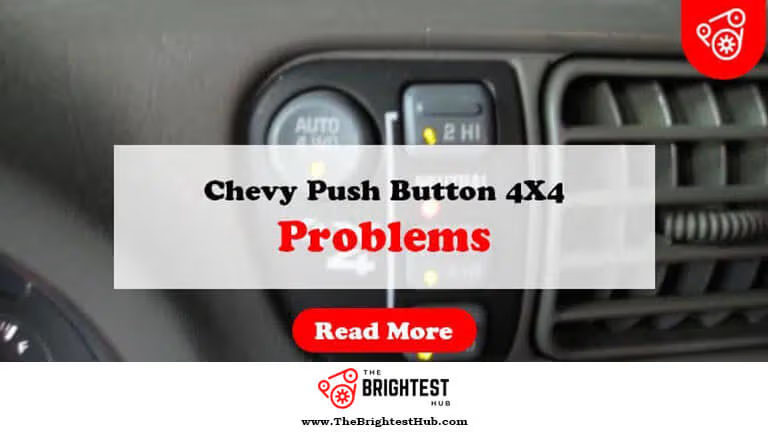Magnetic Ride Control Problems: Quick Fixes & Tips
Magnetic Ride Control problems often stem from faulty sensors or low fluid levels. These issues can lead to poor ride quality and handling.
Magnetic Ride Control is an advanced suspension system designed to enhance vehicle performance and comfort. It uses magnetic fluid to adjust damping characteristics in real-time, providing a smoother ride. While this technology improves handling, it can face several challenges. Common problems include sensor malfunctions and fluid leaks, which can drastically affect driving experience.
Owners may notice a stiffer ride or unusual noises when these issues arise. Regular maintenance and timely diagnostics are essential for keeping the system in optimal condition. Understanding these problems can help drivers make informed decisions about repairs and maintenance, ensuring a safe and comfortable driving experience.
Introduction To Magnetic Ride Control

Magnetic Ride Control (MRC) is an advanced suspension system. It uses magnetism to improve vehicle handling and comfort. This technology adapts to road conditions in real-time. Understanding MRC helps drivers appreciate its benefits and challenges.
The Basics
Magnetic Ride Control operates through a few key components:
- Electromagnetic Dampers: These adjust the suspension stiffness.
- Magnetic Fluid: This fluid changes viscosity with an electric field.
- Control Module: This module processes sensor data.
MRC enhances vehicle performance by:
- Reducing body roll during turns.
- Improving ride comfort on rough roads.
- Offering better stability at high speeds.
Significance In Modern Vehicles
Magnetic Ride Control is crucial for modern cars. It offers several advantages:
| Advantage | Description |
|---|---|
| Enhanced Safety | Improved traction and control on various terrains. |
| Increased Comfort | Smoother rides, even on bumpy roads. |
| Customization | Drivers can choose ride settings based on preferences. |
This technology is found in many luxury and performance vehicles. It enhances the overall driving experience. Drivers enjoy a blend of comfort and sporty handling.
Common Issues Faced
Magnetic Ride Control (MRC) enhances vehicle handling and comfort. However, drivers encounter several common issues. Understanding these problems can help in timely maintenance.
Sensor Failures
Sensor failures can disrupt the MRC system’s performance. Sensors monitor the road conditions and adjust the suspension accordingly.
- Faulty sensors can lead to poor ride quality.
- Warning lights may appear on the dashboard.
- Inconsistent handling is a common symptom.
Regular checks of the sensors can prevent major issues. Replacing a faulty sensor often restores normal function.
Magnetic Fluid Degradation
Magnetic fluid is essential for MRC to work. Over time, this fluid can degrade due to heat and contaminants.
| Signs of Degradation | Possible Effects |
|---|---|
| Increased noise during operation | Poor ride comfort |
| Reduced responsiveness | Inconsistent handling |
| Fluid leaks | Potential system failure |
Regular fluid checks are vital for MRC longevity. Replacing degraded fluid can restore system effectiveness.
Symptoms Of Malfunctioning Magnetic Ride Control
Magnetic Ride Control is an advanced suspension system. It helps improve your vehicle’s handling and ride quality. When this system malfunctions, it can lead to various symptoms. Recognizing these signs early can save you time and money.
Unusual Ride Stiffness
One common symptom is an unusual ride stiffness. This can make driving uncomfortable. A few signs to look for include:
- Feeling every bump in the road.
- Difficulty absorbing shocks from potholes.
- Higher levels of vibration during normal driving.
Stiffness can make your vehicle feel like a sports car. However, it’s often a sign of trouble. Inspect your suspension system if you notice this change.
Erratic Suspension Behavior
Another symptom is erratic suspension behavior. Your car may behave unpredictably while driving. Watch for these signs:
- Sudden changes in ride height.
- Inconsistent handling around corners.
- Unusual noises from the suspension system.
Erratic behavior can make driving dangerous. If your vehicle feels unstable, get it checked by a professional. Early diagnosis can prevent further damage.
Diagnosing Problems Accurately
Diagnosing Magnetic Ride Control problems correctly is crucial. Accurate diagnosis saves time and money. It helps identify real issues versus simple glitches. Understanding symptoms leads to better solutions.
Tools And Techniques
Using the right tools helps diagnose Magnetic Ride Control issues effectively. Here are some essential tools and techniques:
- OBD-II Scanner: Reads error codes from the vehicle’s computer.
- Multimeter: Measures voltage and checks electrical connections.
- Shock Absorber Test: Tests the performance of the magnetic shocks.
- Visual Inspection: Look for leaks, cracks, or loose connections.
| Tool | Purpose |
|---|---|
| OBD-II Scanner | Identifies error codes |
| Multimeter | Checks electrical systems |
| Shock Absorber Test | Evaluates shock performance |
| Visual Inspection | Finds physical damage |
Professional Vs. Diy Approaches
Deciding between professional help and DIY methods is important. Each approach has pros and cons.
- Professional Help:
- Access to advanced tools.
- Expertise in complex issues.
- Warranty on repairs.
- DIY Methods:
- Cost-effective solutions.
- Learning experience.
- Immediate action possible.
Choose wisely based on your skills and the problem’s complexity.
Quick Fixes For Immediate Relief
Magnetic Ride Control (MRC) issues can disrupt your driving experience. Quick fixes offer temporary relief until professional help arrives. Here’s how to manage MRC problems effectively.
Temporary Solutions
Implement these temporary solutions to handle MRC issues:
- Check the Fuse: Locate the fuse box and inspect the MRC fuse.
- Reset the System: Disconnect the battery for 10 minutes.
- Inspect Wiring: Look for loose or damaged wires.
- Adjust Ride Height: Manually adjust if possible.
| Solution | Description |
|---|---|
| Check the Fuse | Ensure the MRC fuse is intact. |
| Reset the System | Disconnect battery to reset the MRC. |
| Inspect Wiring | Look for any loose connections. |
| Adjust Ride Height | Change height manually for better ride. |
When To Apply Them
Use these fixes in specific situations:
- Warning Light: If the MRC light turns on.
- Unusual Sounds: Hear strange noises from the suspension.
- Poor Handling: Notice difficulty in steering or stability.
- Rough Ride: Experience a bumpier ride than normal.
Addressing these symptoms early can prevent further damage.
Long-term Repair Strategies
Magnetic Ride Control (MRC) enhances vehicle handling. Over time, issues may arise. Long-term repair strategies are essential for maintaining performance. Understanding these strategies can save money and improve safety.
Component Replacement
Replacing faulty components can restore your vehicle’s MRC system. Common components that may need replacement include:
- Shock absorbers: Worn shocks affect ride quality.
- Control modules: Malfunctioning modules lead to system errors.
- Wiring harness: Damaged wires can disrupt signals.
Consider the following steps for component replacement:
- Identify the faulty part through diagnostic tools.
- Purchase OEM or high-quality aftermarket parts.
- Follow manufacturer guidelines for installation.
Regular inspections help catch issues early. This can prevent costly repairs later.
System Overhaul
A complete MRC system overhaul may be necessary for severe problems. An overhaul involves:
- Removing old components: This includes shocks, control modules, and wiring.
- Installing upgraded parts: Consider new technology for better performance.
- Reprogramming the system: Ensure all components communicate properly.
Benefits of a system overhaul include:
| Benefit | Description |
|---|---|
| Improved Handling | Better response during turns and stops. |
| Increased Safety | Enhanced stability reduces accident risk. |
| Longer Lifespan | New parts often last longer than old ones. |
Consult a professional for a thorough assessment. This ensures the best results for your MRC system.
Maintenance Tips To Prevent Future Issues
Proper maintenance of Magnetic Ride Control systems can save you time and money. Regular care helps avoid costly repairs and ensures smooth operation. Follow these tips for better longevity and performance.
Regular Check-ups
Schedule regular check-ups for your vehicle. Inspections help identify early signs of trouble. Here are some key points to consider:
- Check the suspension system every 5,000 miles.
- Inspect for leaks in the magnetic fluid.
- Look for any unusual noises when driving.
- Test the responsiveness of the ride control.
Fluid Management
Fluid management is crucial for Magnetic Ride Control performance. Proper fluid levels enhance system functionality. Follow these steps:
- Check fluid levels regularly.
- Replace old fluid every 30,000 miles.
- Use the recommended fluid type for your vehicle.
Keep the fluid clean. Contaminated fluid can damage the system. Always monitor for any signs of leaks.
| Fluid Change Interval | Signs of Contamination |
|---|---|
| Every 30,000 miles | Cloudy appearance |
| Every 30,000 miles | Unusual color |
| Every 30,000 miles | Presence of particles |
Finding Professional Help
Dealing with Magnetic Ride Control problems can be tough. Getting expert help is essential. Professionals can diagnose issues quickly and accurately. They also ensure your car runs smoothly and safely.
Choosing The Right Service
Selecting the right service is crucial. Here are some tips:
- Experience: Look for professionals with experience in Magnetic Ride Control.
- Certifications: Check if they have the necessary certifications.
- Reviews: Read customer reviews and ratings online.
- Warranty: Ensure they offer a warranty on their services.
Ask friends or family for recommendations. A trusted mechanic can save you time and money.
Cost Considerations
Understanding costs is important. Here are some factors that affect pricing:
| Factor | Cost Range |
|---|---|
| Diagnostic Fees | $50 – $150 |
| Parts Replacement | $200 – $1,500 |
| Labor Charges | $75 – $150 per hour |
Get multiple quotes before making a decision. This helps you understand the market rate.
Don’t forget to ask about any hidden fees. Transparency is key when choosing a service.
Frequently Asked Questions
What Are Common Magnetic Ride Control Issues?
Common issues include erratic handling, warning lights, and uneven ride height. These can stem from sensor or actuator failures.
How To Diagnose Magnetic Ride Control Problems?
Check for error codes using a diagnostic tool. Inspect suspension components for leaks, wear, or electrical issues.
Can I Repair Magnetic Ride Control Myself?
Basic checks can be done at home, but repairs often require professional expertise and specialized equipment.
What Causes Magnetic Ride Control Failure?
Failures typically result from component wear, electrical faults, or fluid leaks in the suspension system.
Is Magnetic Ride Control Worth Fixing?
Yes, fixing it restores vehicle handling and comfort, enhancing overall driving experience and safety. “`
Conclusion
Magnetic Ride Control issues can lead to a less comfortable driving experience. Regular maintenance is crucial to prevent these problems. Stay informed about potential warning signs. Addressing issues early can save time and money. Prioritize your vehicle’s performance for a smoother ride.
Understanding these challenges will help you enjoy your driving experience.






